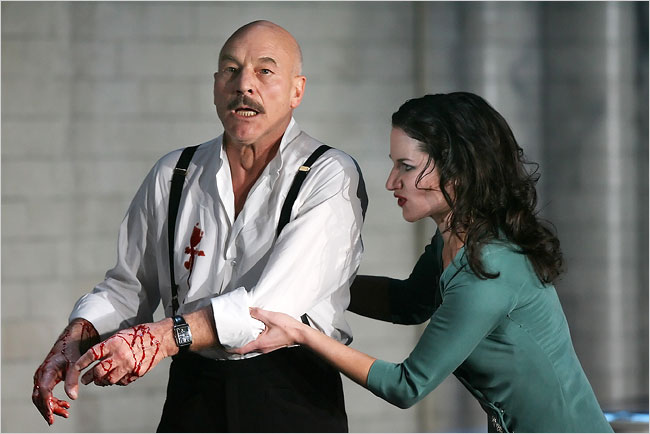By Ray Bennett
LONDON – Seldom can Shakespeare’s murky Scottish tragedy “Macbeth” been have staged with so much clarity and emotional punch as in Rupert Goold’s exhilarating production at London’s Gielgud Theatre. It stars Patrick Stewart in probably the finest performance of his career in the title role.
Created at the Chichester Festival Theatre and bound for Broadway, the show is staged in two 80-minute acts that pound the senses and seize the imagination in ways that make the ancient tale of unbridled hubris vitally modern.
Using a stark basement setting reminiscent of Beckett’s forlorn “Endgame,” Goold stages the play in cinematic terms designed to establish a mood of dread as Macbeth and his wife bloody their hands in order to become rulers of an unruly state.
Soviet-style uniforms, video images of crushed rebellion and machine guns establish a bleak 1950s mood as Macbeth conspires to eliminate his rivals to the throne. The references might be to kings, princes and thanes, but Macbeth is a mid-management desperado seeking the top job — in business and politics — and he is willing to use all ruthless means to have his way.
This involves murdering the Scottish king, Duncan (Paul Shelley), while he sleeps and also killing his guards in order to lay off the blame. The king’s sons flee, suggesting mistakenly that they might have been complicit, while stalwarts Banquo (Martin Turner) and Macduff (Michael Feast) go along with crowning Macbeth.
Full of bluster but also deeply deranged, Macbeth suspects everyone and is soon arranging torture and more ugly deaths, including those of rivals Banquo and Macduff. But Macduff is away when his assassins come to call, and the slaying of his wife and children lead him to an alliance with the late king’s son, Malcolm (Scott Handy). With a force of soldiers loaned by the English, they head to Macbeth’s castle seeking vengeance.
Framed in the manner of a gangster film, the production uses imaginative lighting and sound to amplify the play’s supernatural elements. The three witches (“Double, double toil and trouble”) are portrayed as nurses who are definitely weird sisters. Banquo’s ghost shows up bloodily corporeal at the end of Act 1, but when the curtain rises again the scene is repeated showing that only the harried Macbeth can see the spectre of his slain enemy.
Stewart demonstrates that many years of “Star Trek: The Next Generation” and big-screen outings in “The X-Men” movies haven’t diminished his stage presence one iota. He inhabits the role and is matched in intensity by Kate Fleetwood (pictured with Stewart) as Lady Macbeth and Feast as Macduff. Also making vivid contributions are Suzanne Burden as the doomed Lady Macduff and Turner as Banquo.
Designer Anthony Ward, and all the design talents, deserve high praise but especially music and sound designer Adam Cork. It is director Goold, however, who will be most applauded for his dynamic interpretation of a jaded classic.
Venue: Gielgud Theatre; Cast: Patrick Stewart; Kate Fleetwood; Paul Shelley; Scott Handy; Ben Carpenter; Martin Turner; Michael Feast; Suzanne Burden; Sophie Hunter; Polly Frame; Niamh McGrady; Mark Rawlings; Tim Treloar; Bill Nash; Playwright: William Shakespeare; Director: Rupert Goold; Designer: Anthony Ward; Lighting designer: Howard Harrison; Music/sound designer: Adam Cork; Video/projection designer: Lorna Heavey.

